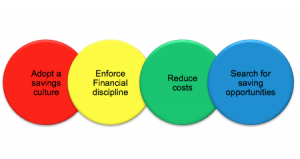The biggest asset to any small to medium business is often not its assets or contracts, but its cash flow. Cash flow is the money that flows in and out of the business and it is important that a business has a healthy net positive cash flow.
It is therefore of great importance for any business to try and save capital that can be used to bolster its cash flow. Most cost saving activities can be split into those that encourage economies of scale, and those that require greater efficiencies in performing activities.
- Adopt a savings culture
- Enforce financial discipline
- Reduce costs
- Search for saving opportunities.
1. Adopt a savings culture
A savings culture helps to remove mental scarcity and it is a doorway to wealth creation. Saving, no matter how small the amount, will eliminate the frame of mind of ‘there is not enough’. Start today, and encourage this culture throughout your business.
2. Practice consistent financial discipline
Financial efficiencies and discipline can also assist a business to grow.
- Organise your financial documents
- Create a budget (budget software is a great help here)
- Create an expense vs income balance sheet
- Set savings goals
- Put savings aside or invest them at the beginning of the month, to avoid temptation
These efficiencies also can include operating with a majority of contract workers in the first two years. This will help a business reduce its wage bill with lower benefit contributions in the form of a medical aid and pensions. Only when established should a business consider a large permanent workforce.
A business can also save money by hiring professional service providers for functions such as payroll, accounting and human resources. This is much cheaper than hiring full time professionals.
Vehicle leasing and hire purchase costs also require prudent financial planning with a professional business financial planner or accountant. This is to ensure that a business can maintain a positive cash flow when meeting such obligations. Management reporting must be kept current at all times and used as a tool for decision-making.
3. Reduce costs
Running costs:
The office is the operational nerve centre and hub of a thriving business. It is also a potential source of inflated costs and losses to a business. It is important to audit the office environment to discover any money saving opportunities.
The office is also the communications centre and efficient communications is one way of saving on business cash flow. There are many providers that now offer bundled communications services that include telephone, fax, data and cell phone services in a single payment. Paying one service provider can offer a cost-effective way to run your office.
Another major office expense is the office printer. Here, a business may consider going paperless and this will also reduce document storage costs and charges. You can share information by scanning documents; saving your business time and money.
Where it is absolutely necessary to print documents, it is advised that all printing is done on double sided paper at all times, with colour prints controlled. Modern printers which track user print activities will also discipline employees to avoid wastage.
Bank charges and logistics:
Businesses can negotiate a range of charges and interest rates with their bankers. With this in mind, small businesses must not be afraid to talk to their bankers, as even a small reduction in charges can be beneficial over time. If dissatisfied with your bank’s service, a business can vote with its feet and look for a financial institution that suits its requirements.
Shopping around for the best quotes can also save transport and courier costs. With rising fuel costs, it is important to use fuel efficient vehicles and plan delivery routes using a good GPS system.
Save on property leases:
It is common knowledge that the vast majority of small and medium enterprises are at the greatest risk of business failure in the first year. It is therefore advisable to avoid a long term lease contract enter into short term or shared occupation arrangements where possible.
These short term leases allow a growing business to move to larger suitable premises, close shop or relocate to another location if there are challenges.
It is for this reason that many small businesses are started in the homes and garages of their founders. Although a smart office gives clients a great impression, this need must be balanced with the need for business sustainability. If such premises are not an absolute must, thousands of Rands can be saved.
Loyalty Cards:
Loyalty cards are often associated with personal spending with most banks. It must however be noted that business accounts often qualify for discounts and incentives which can be used to pay for business expenses.
The CEO of FNB Bank Jacques Celliers notes that FNB’s loyalty programme eBucks can be used to pay for expenses such as fuel, electricity, airtime, business equipment or even travel expenses. It is prudent for a business owner to try accrue such benefits on spending which would have normally occurred in daily business activity. Such benefits can even be used by a sole proprietor for personal use.
4. Search for saving opportunities
When a business is always seeking to find and create savings, the business will be less at risk of failure. My main advice is to always be on the lookout for ways to save money and find new opportunities to benefit from economies of scale as your business grows.









